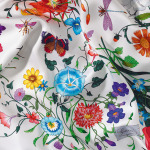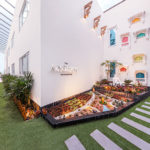A Working Lunch
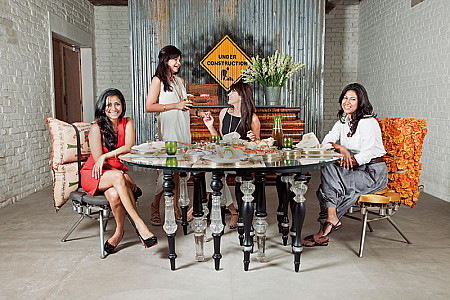
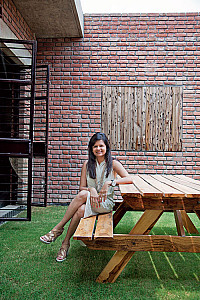
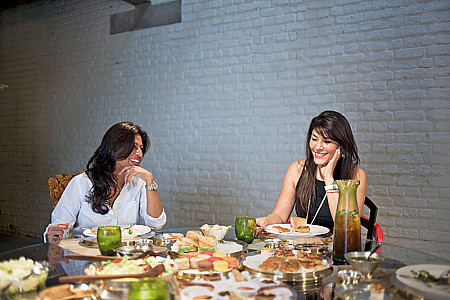
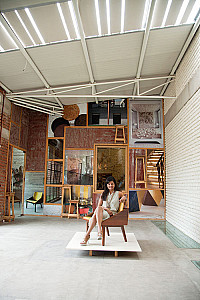
Driving down the narrow, dusty streets of Mehrauli while taking note of signboards outside the rows of farmhouses can be a Herculean task but thanks to Google maps, we reached 10 minutes before schedule. As the large gates opened to let our car in, the rust-coloured warehouse appeared ordinary. Too plain for a designer’s workspace; but the outside structure defied what was in store within. A former shed that belonged to interior designer Gunjan Gupta’s husband’s family was recently expanded and built up using the reverse construction formula; the scaffolding, salvaged from construction was left behind, giving it a fragmentary look and the décor was eccentric. Be it the unconventional furniture with a bar area made from hollow drainage pipes and an under-construction signpost perched on wavy aluminum sheets or the picnic table on the manicured man-made lawn upstairs, the concept was out of the blue. Unconventional and progressive, it displayed the capricious sense of style of this new designer on the block. No wonder her creations went off the shelf within hours of display at the Milan Design Fair this year.
In one corner of the room, her team was setting the lunch table, as Gunjan supervised. Everything had to be flawless and at the exact degree and distance from each other. The perfectionist wouldn’t settle for the ordinary. Her friends Feroze Gujral, Deepshikha Khanna and Aparajita Jain who were on their way were looking forward to this long due lunch. Nothing beats afternoon chatter with your ‘besties’ (best friends, of course!) over crunchy salads, sumptuous sandwiches, delicious macaroons and sparkling drinks to wash it all down.
Dressed in white, gallerist Aparajita Jain was the first to arrive. Like Gunjan, she too has shifted base here. Gunjan, a Mumbai-bred girl had moved post her wedding to a Delhi-based entrepreneur and admits that her evolution as a designer began in the capital city. “I discovered and began to love Indian art and styles,” she says. Post her graduation from Sophia Polytechnic, Gunjan had assisted designer Varsha Desai in Mumbai while working on interesting projects like the Ambani home. “Varsha’s clients were affluent but back then, the resources were limited. Not many families were aspirational in terms of design and often referred to the few design catalogues that were specially imported to get them imitated. Travelling to Milan to shop for furniture was unheard of and people stuck to clichés. The possibilities for creativity were limited,” she says.
A couple of minutes later, her friend from Mumbai, Deepshikha arrived. A textile designer by profession, the two know each other from their Mumbai days for more than a decade now, and together, the three can’t wait to discuss and catch up on the latest from the world of art and fashion. Meanwhile Feroze walks in and there is more chatter.
The three girls have been personal fans of Gunjan’s work and admire her ability to capture luxury in a traditional yet contemporary way, unlike the royal pieces of Jaipur and Agra that often seem so nostalgic. For Gunjan, it was always about wanting to create something new that was ‘Made In India’. Her exposure abroad made her unravel the ethos of crafts revival where sustainability is the key.
Her daughter was two years old when she went to do a Masters Graduate in Furniture Design from Central Saint Martins College of Art & Design in London. That’s where she realised that the future of Indian luxury lay in value addition. A whole universe unravelled for Gunjan. She started Wrap Art & Design.
At the Milan Furniture Fair, she had a small kiosk but she received instant recognition for doing niche furniture with curious designs that were easy and quirky. “Milan is the Mecca of design; Gunjan had to have a presence there. Her booth had just 15 contemporary pieces that were a memory of India in a different way – thrones, narration, tables and dining tables. Italian designer Rossana Orlandi bought it all. It became the talk of the town in Milan,” informs Feroze.
“Gunjan’s work is mixed with a story-telling approach, a sort of cultural narrative derived from her travels and the architecture of the destinations. In here is a whole experience, making edgy artifacts,” says Deepshikha. Gunjan wants to sell her furniture in an innovative space, like a by-appointment gallery in her warehouse where her works will be displayed alongside cutting-edge European designers. “I don’t believe in a single retail format, the positioning of my work is really important and thus different. It makes sense, this whole idea of upgrading Design India,” she quips.
Her ‘dinner stack’ project, a deconstructed gold and silver sculpture, has a western function but the concept is India-inspired. This is how we used to store our utensils. “It’s sensitivity refined for a stylish hostess so that she can entertain with a difference,” adds Gunjan who had in fact met Feroze while working on this project.
As everyone gets comfortable in the quirky chairs, Aparajita is quick to take notice of the conventional silverware. It’s the one that Gunjan designed for TBZ and Aparajita is a personal fan. “It’s avant-garde don’t you think,” she asked, holding a spoon in her hand. “Gunjan’s work is like a breath of fresh air,” she added. We continued the conversation which moved towards the young designer’s inspirations. “I was young to do what I was doing. Repositioning the ‘Made in India’ tag is a huge responsibility. Putting India on the map of contemporary design is not a commercially driven agenda. Versatility of the product matters,” says Gunjan whose job is to conceptualise, give creative direction and lead an innovative strategy for a team that consists of design graduates, both freshers and experienced professionals from all over the world, some of whom she collaborates with on select projects. “It allows a flow of creativity. People join us because we are not cookie cutters; being creative is more satisfying than working for a bigger brand. Everyone on the team feels involved in the creative process,” she adds.
But the most interesting part of her job, she maintains, is to train her craftsmen. “The real execution of the design lies in their hands. Comprehension may be difficult at times but the ones on my team are really interested in pushing the corners. Their feedback is incredible. Everybody has their own imagination but these people have more design alignment than us. We follow internationally best practices and the end product is in sync with what you had in mind,” she says.
With their busy schedules, sometimes the only time the girls get to catch up with each other, is when they play golf or during an occasional working lunch like this one; the latter of course is just the perfect way to start the week.
Creating edgy artifacts
Started by Gunjan Gupta in 2006, Wrap is a contemporary luxury and lifestyle brand that works on reviving and invigorating India’s traditional crafts and positions them in contemporary homes. Under this brand, Gunjan has exhibited widely at trade fairs across the world including a special show at Sotheby’s in London and has collaborated on special design commissions with Droog Design in Amsterdam and with Swarovski in Paris.
Her efforts in repositioning the ‘Made in India’ brand internationally have won her global recognition that includes several awards and accolades. She has even curated the India design exhibition at the Experimenta Design Biennale in Lisbon.
Related posts from Verve:
Verve Trending
Sorry. No data so far.
us on Facebook to stay updated with the latest trends


